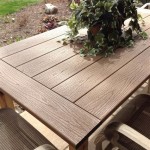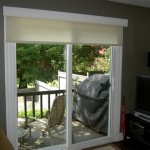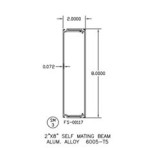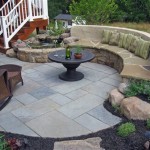Concrete Patio Benches: Durability and Design for Outdoor Living
Concrete patio benches represent a robust and aesthetically versatile seating option for exterior spaces. Their inherent strength, coupled with design flexibility, renders them a popular choice for residential properties, commercial establishments, and public parks alike. This article explores the characteristics, advantages, selection criteria, installation considerations, and maintenance practices associated with concrete patio benches.
The Enduring Appeal of Concrete: Material Properties and Benefits
Concrete, a composite material composed primarily of cement, aggregate (sand, gravel, or crushed stone), and water, possesses a unique combination of attributes that contribute to its suitability for outdoor furniture. The hardened cement paste binds the aggregate together, forming a dense and durable matrix capable of withstanding significant loads and environmental stresses. The following highlights some key benefits:
Durability: Concrete's inherent strength allows it to endure exposure to a wide range of weather conditions, including extreme temperatures, rain, snow, and ultraviolet radiation. Unlike wooden or metal benches, concrete benches are less susceptible to rot, rust, or insect infestation. This robustness translates into a longer lifespan and reduced maintenance requirements.
Stability: The weight of concrete ensures that patio benches remain securely in place, even in windy conditions. This stability is particularly advantageous in exposed outdoor spaces where lighter furniture may be prone to tipping or being blown around. The bench's weight also acts as a deterrent to theft, making it a more secure option for public areas.
Versatility: Concrete can be molded into virtually any shape or size, allowing for a high degree of design flexibility. This design adaptability extends to surface finishes, which can be textured, polished, stained, or painted to achieve a desired aesthetic. Concrete can also be integrated with other materials, such as wood, metal, or stone, to create visually appealing and functional bench designs.
Low Maintenance: Compared to other outdoor furniture materials, concrete requires minimal maintenance. Regular cleaning with soap and water is typically sufficient to remove dirt and debris. Applying a sealant can further protect the concrete surface from stains and water damage, extending its lifespan and preserving its appearance.
Sustainability: Concrete can be produced using recycled aggregates and supplementary cementitious materials, reducing its environmental impact. Its long lifespan and low maintenance requirements also contribute to its sustainability by minimizing the need for replacement and reducing resource consumption.
Selecting the Right Concrete Patio Bench: Factors to Consider
Choosing the appropriate concrete patio bench involves careful consideration of several factors, including design, size, weight, finish, and budget. A thorough assessment of these aspects will ensure that the selected bench meets both the functional and aesthetic requirements of the intended space.
Design and Style: Concrete patio benches are available in a wide array of designs, ranging from simple and minimalist to ornate and decorative. The design should complement the overall architectural style of the surrounding environment. Consider geometric shapes, curved forms, and integrated planters to enhance the visual appeal of the bench and its surroundings. Furthermore, backless benches offer a more modern and open aesthetic, while benches with backs provide added comfort and support.
Size and Seating Capacity: The size of the bench should be proportionate to the space in which it will be placed. Measure the available area carefully to ensure that the bench fits comfortably without obstructing pathways or creating a cluttered appearance. Determine the desired seating capacity based on the anticipated number of users. Longer benches can accommodate multiple individuals, while shorter benches may be more suitable for smaller spaces or intimate settings.
Weight and Portability: Concrete benches are inherently heavy, which contributes to their stability but also limits their portability. Consider the weight of the bench when planning its installation and placement. If the bench needs to be moved occasionally, opt for smaller, lighter models or those equipped with lifting points or casters. However, for permanent installations, the weight of the bench can be an advantage, providing security and deterring theft.
Finish and Texture: The surface finish of the concrete bench can significantly impact its appearance and feel. Smooth, polished finishes offer a sleek and modern aesthetic, while textured finishes provide a more rustic and natural look. Consider the desired level of slip resistance when selecting a finish, particularly in areas that may be exposed to moisture. Stained or painted concrete can add color and dimension to the bench, allowing it to blend seamlessly with the surrounding landscape or architectural elements.
Cost and Budget: The price of concrete patio benches can vary depending on the size, design, finish, and complexity of the construction. Establish a budget beforehand and compare prices from different suppliers to ensure that you are getting the best value for your money. Consider the long-term cost of ownership, including maintenance and potential repairs, when evaluating different options.
Installation and Maintenance: Ensuring Longevity and Performance
Proper installation and maintenance are essential for maximizing the lifespan and performance of concrete patio benches. Following established guidelines and implementing a regular maintenance schedule will help prevent damage, preserve the aesthetic appearance, and ensure the long-term durability of the bench.
Site Preparation: Before installing a concrete bench, ensure that the site is level and stable. Remove any debris, vegetation, or loose soil from the area. If the ground is uneven or unstable, consider creating a concrete pad or gravel base to provide a solid foundation for the bench. This will prevent settling or tilting, which can lead to cracking or other damage.
Installation Procedures: Carefully position the concrete bench in the desired location. Use shims or wedges to level the bench if necessary. For added stability, consider anchoring the bench to the ground using concrete adhesive or mechanical fasteners. This is particularly important for benches in public areas or those exposed to strong winds. Handle the bench with care during installation to avoid chipping or cracking the concrete surface.
Sealing and Protection: Apply a concrete sealant to the surface of the bench to protect it from stains, water damage, and ultraviolet radiation. Choose a sealant that is specifically designed for outdoor use and follow the manufacturer's instructions carefully. Reapply the sealant periodically, as needed, to maintain its protective properties. Consider using a cover to protect the bench during harsh weather conditions, such as prolonged periods of rain or snow.
Cleaning and Maintenance: Regularly clean the concrete bench with soap and water to remove dirt, debris, and stains. Use a soft brush or sponge to avoid scratching the surface. For stubborn stains, consider using a concrete cleaner or pressure washer. Avoid using harsh chemicals or abrasive cleaners, as these can damage the concrete surface. Inspect the bench periodically for cracks or other damage and repair them promptly to prevent further deterioration.
Repairing Cracks and Damage: Cracks in concrete can occur due to thermal expansion and contraction, ground movement, or impact damage. Small cracks can be repaired using a concrete patching compound. Larger cracks may require more extensive repairs, such as epoxy injection or concrete resurfacing. Consult with a concrete repair professional for advice on the best repair methods for specific types of damage. Addressing cracks promptly will prevent water from entering the concrete and causing further damage due to freeze-thaw cycles.
By adhering to these guidelines for installation and maintenance, property owners can ensure that their concrete patio benches remain functional, aesthetically pleasing, and structurally sound for many years to come. The investment in proper care will be rewarded with long-lasting performance and a welcoming outdoor space.

Concrete Garden Benches Ideas On Foter Seating Bench Modern

Concrete Garden Benches Ideas On Foter Diy Furniture Bench Outdoor

Modern Concrete Patio Cheng Exchange

Outdoor Living Concrete Projects Diy Patio Bench Garden

Patio With Concrete Bench And Long Fire Pit Contemporary Deck

The Best Garden Benches Of 2024 Concrete Outdoor Table Furniture Bench

Cement Garden Benches Google Search Concrete Bench

Getzen Concrete Outdoor Benches Park Palmer Hamilton

Concrete Garden Benches Ideas On Foter Seating Bench

Microcement Concrete Outdoor Bench Or Seat Stone Inside
Related Posts








